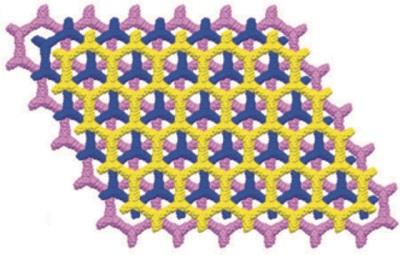A step to understanding polymorphs

This is an overhead view of the hexagonal sheets, shifted in respect to each other. Credit: Zentner et al
This study lies at the very heart of understanding and being able to control properties of molecular structures. Pharma and agrichem industries attach great importance to understanding crystal structure.
The solid form impinges directly on properties such as solubility, bioavailability, processing characteristics, bulk density, dissolution rate, permeability, surface electrostatic charge and so on, so it is imperative to have a clear understanding of the molecular-level make-up of a material and how this affects its properties.
This study illustrates that the high Z' phenomenon, like polymorphism itself, has many root causes but careful study of each structure allows the identification of organization principles in most cases.
Brock leaves the door open for future research saying “very few structures are so complex that it is difficult to understand how the crystals could have formed”.
This comprehensive survey, in conjunction with a groundswell of work by a number of groups on this increasingly intriguing problem over the past 20 years, shows that there is no one-size-fits-all explanation and that the details of each structure are uniquely tied to the chemical details of the molecules that comprise it. The search goes on, but perhaps we are now at least beginning to know how to formulate the question.
Media Contact
All latest news from the category: Life Sciences and Chemistry
Articles and reports from the Life Sciences and chemistry area deal with applied and basic research into modern biology, chemistry and human medicine.
Valuable information can be found on a range of life sciences fields including bacteriology, biochemistry, bionics, bioinformatics, biophysics, biotechnology, genetics, geobotany, human biology, marine biology, microbiology, molecular biology, cellular biology, zoology, bioinorganic chemistry, microchemistry and environmental chemistry.
Newest articles

Recovering phosphorus from sewage sludge ash
Chemical and heat treatment of sewage sludge can recover phosphorus in a process that could help address the problem of diminishing supplies of phosphorus ores. Valuable supplies of phosphorus could…

Efficient, sustainable and cost-effective hybrid energy storage system for modern power grids
EU project HyFlow: Over three years of research, the consortium of the EU project HyFlow has successfully developed a highly efficient, sustainable, and cost-effective hybrid energy storage system (HESS) that…

After 25 years, researchers uncover genetic cause of rare neurological disease
Some families call it a trial of faith. Others just call it a curse. The progressive neurological disease known as spinocerebellar ataxia 4 (SCA4) is a rare condition, but its…





















